Les, Drugs and Rock & Roll
Saturday, July 15, 2006
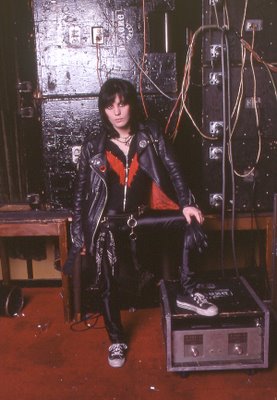
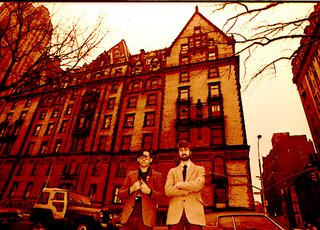
Before I moved with Rosemary, Ale and Hilary to Vancouver in 1975 my knowledge of rock and roll was limited to three acts, the Allman Brothers Band, The Beattles and Creedence Clearwater Revival. At the American high school in Mexico City where I had taught my students were appalled. One day they asked me if I had ever heard of Alice Cooper. They all sighed when I answered, "No, who's she?" So they gave me a copy of The Allman Brothers Band at Fillmore East and my introduction to rock and roll began. A "hip" Mexico City radio station ran a daily contest in which they played the Beattles and Creedence Clearwater Revival. At the end of the day listerners would vote in the "world's best band". Vancouver for me was definitely an innocent abroad situation. I knew no better. This was all corrected when I started working for Vancouver Magazine and was paired as the photographer to rock critic Les Wiseman's writing. He wrote his monthly In One Ear column in which he ( a snob of snobs) imposed his taste in rock & roll on innocents like me. Since I didn't know any better I learned well, and I too, was soon telling people, "If you feel that you have to listen to heavy metal there is only one band worth listening to and that's Motorhead." I just repeated what Wiseman had taught me. My daughters, who were becoming teenagers would say, "You mean you photographed Joan Jett today?" (top,left) They could not believe my good fortune. I tried to transfer my newly acquired wisdom on them and soon Hilary could recognize Johnny Thunders and Iggy Pop.
It was around the mid 80s that Les Wiseman and I decided to go to New York City to see if we could secure work with Rolling Stone. Both of us managed to show our stuff but in the end the editors of Rolling Stone (they all looked like Elvis Costello) told us that while they thought our work was excellent they were not interested in a story on Red Rider. The bad news did not prevent us from enjoying all the sites of the city including the Metropolitan, the Algonquin and the Guggenheim. But we also managed to see Johnny Thunders at CBGBs and Lou Reed at the Bottom Line. It was only years later through my daughters and now my granddaughter that I realized how lucky I was to be Wiseman's Lenso (that's what he called me) who always treated me as "my attorney". One place we did go to, for different reasons, was the Dakota. He went because of John Lennon and I went because of Jack Finney's 1970 novel Time and Again. And we took no drugs. My attorney always suggested beer.
The Sukhoi Su-32"FN" & Alexandra Elizabeth Waterhouse-Hayward
Friday, July 14, 2006
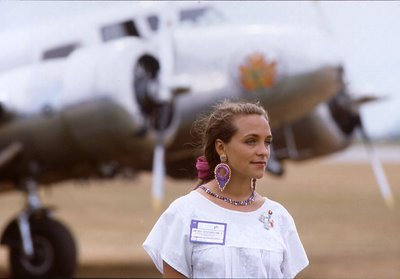
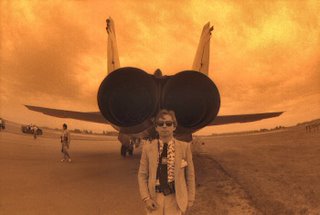
When my uncle Harry (my father's oldest brother was born) his father Harry Waterhouse Hayward had not yet married my grandmother Ellen Carter. My father argued that, technically, Harry, the son could not have Waterhouse as his middle name. This was an honour bestowed on the firstborn male and Harry was not a legitimate firstborn even though his father and mother married later. When I came along, my father George Hayward named me Jorge Alejandro Waterhouse-Hayward. In Argentina, until recently, babies could not have foreign names. The only way my father was able to insert Waterhouse as a middle name was with a hyphen and a 50 peso bribe. And that is how I became the first and last male of the family to have that surname. My daughters will not transfer the name to anybody and up to know I have two granddaughters. When Hilary Waterhouse-Hayward Stewart was pregnant for the second time I told her I would disown her if she had a little boy! What could I possibly do with a male grandson? I love my two little females, Rebecca and Lauren.
Perhaps my fondness for the little girls has all to do that my eldest daughter, Alexandra (Ale) Elizabeth Waterhouse-Hayward, besides being most beautiful and femenine, she also has the qualities of the perfect son. Consider that she can assemble barbecues and Ikea furniture in record times while I am hopeless at it. Best of all, Ale loves airplanes. Could I hope for more? She was so keen on airplanes that Patrick Reid gave her a job at the trade arm of the Abbotsford Air Show (Airshow Canada) for a few years and Ale was even hired by the Chilean Airforce to go to Santiago to help them there with an airshow. Going with Ale to an airshow was fun as she not only admired many of the airplanes that I admired, like the Sukhoi here, but also I must admit that after the F-100 Super Sabre I lost count with American fighter plane nomenclature. Ale can tell the difference between the F-15 and the F-18 and knows what a Tomcat looks like. One of my favourite photographs ever is one that Ale took of me with our favourite Sukhoi.
Allan Morgan, Sarah Rodgers, Humphrey Bogart, Juliet Stevenson
Thursday, July 13, 2006
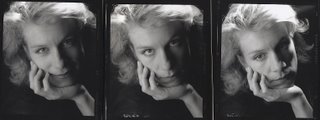 | Juliet Stevenson
|
In the early 90s I had the luck to photograph British actress Juliet Stevenson in the Sun Room of the Vancouver Hotel. While it is obvious to most people that actors can act, we photographers are known for not being too swift. I was astounded how Ms Stevenson could change from one expression to another (after my instructions) and I have never forgotten the lesson. Fortunately there are other photographers, like Latvian born Philippe Halsman who knew this and wrote about it eloquently:
 | |
I was standing on the dock waiting for Bogart. Far out on the sea I could see him alone in a small sailboat and I waved. When he noticed me his boat sailed toward me with such speed that I expected it to crash against the dock. But at the last moment Bogart suddenly veered it 90 degrees and the boat stopped in front of me.
Bogart leaped on the dock and shook my hand. "How would you like to shoot me," he asked, "as a detective or as a criminal?" "I want to photograph you as yourself, "I said without thinking that it would frighten him.
It is not easy to photograph an actor as himself, because often he has the feeling that his "self" is only an empty shell. He tried to hide it by assuming the personality of the different characters he habitually portrays. Very often this feeling of inner emptiness is the very reason for his becoming an actor in the first place.
The moment Bogart faced my camera he completely desintegrated. He could not act the tough guy as usual, because we both knew it would be phony. He did not know what to do with his hands, he could not look at my lens, he trembled with embarrasment, and his plight was so pathetic that I started talking to him as if to a frightened child. Eventually my conversation helped him to become calmer, his attack of jitters passed, and I got a few pictures that showed more than the mask he usually wore.
Many years later I read about Bogart's last days. He was dying of cancer and bearing it with incredible courage and toughness. Was this heroism the apotheothis of his acting career or had it become the man he had played most of his life?
Last week when I faced actors Allan Morgan and Sarah Rodgers I was again amazed at how actors can act on demand and my fortune that as a photographer I can be a temporary director. They were in my studio for a photograph that will accompany a preview article in today's Georgia Straight on their participation in the forthcoming Hoarse Raven Production of Angels in America. While most of us think that Roy Cohn was a despicable character, Morgan, who plays him, displayed for me a more sympathetic take. I told Rodgers, who is an angel, to save the man from himself. This she did and I took 6 or 7 pictures very quickly just in case the moment disappeared.
Flying Saucers & Sweet Peas
Wednesday, July 12, 2006
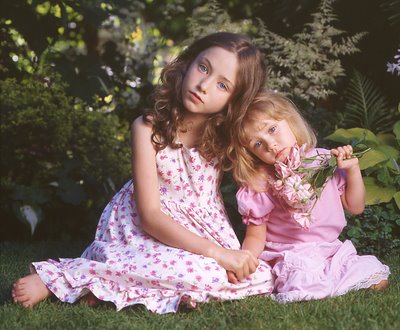 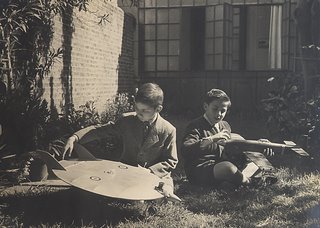 For as long as I can remember there has been a garden in my life. About 10 years ago I went to Rex Murfitt's garden in Victoria and Rex invited me into the kitchen for sandwiches. There was a vase of sweet peas on the kitchen table and when I saw them I realized I had not seen any since my youth. Yet their sweet scent was somehow recorded in my memory and when I put my nose to them I knew exactly what to expect. I was 8 or 9 when this photo was taken of my first cousin Wenceslao de Irureta Goyena and me (with the flying saucer) in our Buenos Aires garden on Melián 2770. Our neighbourhood was named Coghlan after the nearby train station by the same name. Our narrow but long garden had a wisteria and a variety of plum trees including one that was a cross between a plum and a cherry. We also had a khaki and I loved eating the unripe fruit. The puckering of my mouth was a novelty. Some years later we had a large garden on Sierra Madre Street in Mexico City. I was into explosives in those days and I mixed a large quantity of aluminum powder with pottassium chlorate, which my neighbourhood drugstore sold for I don't know what reason. I buried the mixture in a tin can under a hole in one of my mother's rose bushes. I triggered the explosion with a battery, a long cable, and a very thin piece of wire. The explosion sent the bush into the air. I got a sound spanking and a month later the bush flowered like it had never flowered. Our garden on Athlone Street is now a bank of future memories for my granddaughters Rebecca (left) and Lauren (right) who posed for me last week. Lauren is holding a rose called Rosa 'Sexy Rexy'. I have tolerated its sporadic flowering because I had thought it was named after that notorious womanizer Rex Harrison. I have found out that this is not the case (that it is not named after Rex Harrison). Since explosive ingredients are no longer readily available I will have to live with Sexy Rexy, after all she reminds me of Lauren.
A Visit From The Garden Snobs
Tuesday, July 11, 2006
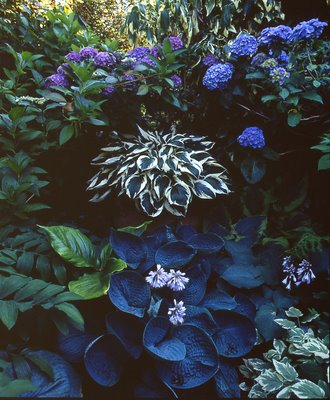 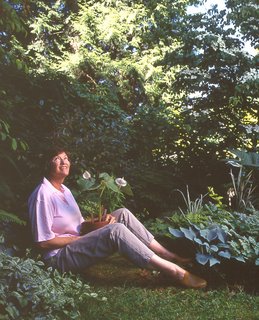 Opening a garden (left) has some strange rituals. Those who come cannot use the facilities and in most situations not even coffee or tea is offered. If there is more than one open garden in a tour, offering goodies could escalate into a goodies war. Since there are only two gardens in today's Vancouver Hardy Plant Group tour, I am going to make my famous iced tea (secret ingredient, Russian Caravan tea). The 400 plus enthusiasts that visited our garden on the city tour during two days a few weeks ago did not ruffle my wife's feathers all that much. This time around she is all nerves. There are around 500 members of the Vancouver Hardy Plant Group and they are mostly mature women who are serious gardeners. The uncrowned queen is Pamela Frost(above right, holding an Arisaema candidissimum) whose garden on Elm Street(besides being exquisite) has the rarest and best plant specimens in Vancouver. Most of the plants in her garden (including a white rhododendron whose flowers have the scent of watermelon) she has patiently grown from seed. The VHPG holds no meetings. They simply visit gardens, publish an excellent bulletin and invite speakers (mostly British) to speak to us. While the roses are fading we are hoping our visitors will appreciate our many varieties of hydrangeas, including an extremely rare Hydrangea serratifolia (Take that, Pamela!) whose flowers, before they open, resemble a ping pong ball. Rebecca and Lauren (my granddaughters) will be present in their flower-print dresses to act as hostesses when the ladies begin arriving at 6:30. Tomorrow morning we will wake up to the usual depression mixed with relief of knowing that no more people will be coming to the garden unless we invite them. Should we let the garden go?
The Elegant Afghan
Monday, July 10, 2006
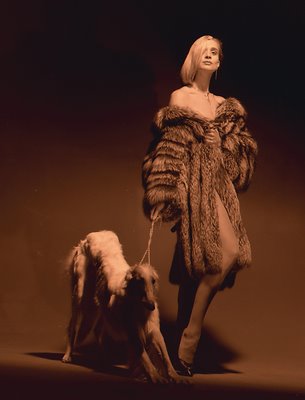 Sometimes I have that photographer's luck of being able to snap that one picture in the midst of others that are not in the least memorable. Here you see Daphne Pappas wearing a fur coat (her family sells furs, so this one is very expensive) panty hose and pumps. I gurantee she was not wearing anything else.
Giboshi Man - Wolfram George Schmid
Sunday, July 09, 2006
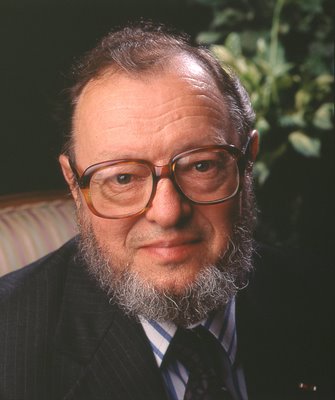
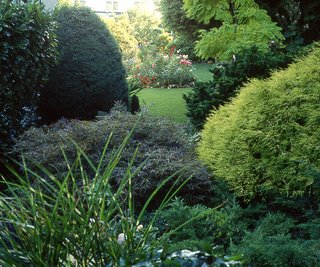
I first met W. George Schmid at the American Hosta Society's National Convention in Columbus, Ohio in 1992. At first I was afraid of approaching the tiny and short man with the large glasses and the strange German/Southern accent. But I soon learned that he was one of the friendliest of the hosta gurus in attendance. He told me that he was an engineer who had designed rocket launching platforms for NASA. When he moved to Atlanta in the 60s he was confronted with one of his toughest "technical" problems. He seemed to be unable to grow anything in his red Atlanta clay garden. This was the case until he bought some Hosta 'Honeybells'. This is an ordinary (but has fragrant flowers) hosta of no particular merit except that it grew well in red clay. Schmid was hooked. He researched the plants for 15 years and realizing that most of them (the Giboshi as hostas are called) came from Japan he learned Japanese. In 1991 he published the ultimate book on hosta, The Genus Hosta.
Schmid represents a lonely faction within the American Hosta Society. He loves green plants and thinks that the multi-variegated forms are difficult to place in a garden. These plants often revert to green and he calls them "dishonest" as oposed to his "green" friends.
Because of his knowledge in all things hosta Schmid is in charge of Nomenclature (with a capital N!). He speaks with such precision that I would love to see him dressed up as the Swedish Linnaeus who invented the system.
But as technical and precise as this man is he has taught me much that has to do with the design of a garden. Once he confessed to me that he talked to his plants, I didn't feel so embarrased that I did, too. His concept of "shoulder to shoulder" gardening, in which individual plants compete for space so that by the end of May I cannot see a square inch of dirt in my flower beds, is pure Schmid. It was Schmid who pointed out (it wasn't obvious to me then) that by placing a "blue" hosta next to a "gold" hosta the gold and blue plants would each be more intense in their colour. My Argentine painter friend, Juan Manuel Sanchez was almost speechless when I told him. " You mean you didn't know this? " He further advised me to bring in a third colour purple.
But Schmid's influence and legacy is increasing in my garden as I eschew bold hostas and select plants with that infinite variety of green that calms the nerves and brings peace to the soul.
|




















